Matched Asymptotic Expansions to the Circular Sitnikov Problem with Long Period
Abstract
The circular Sitnikov problem is revisited, using matched asymptotic expansions. In the case of large oscillation periods, approximate analytical expressions for the period and the orbit of the third body are found. The results are compared with those described in the literature and show that the movement of the third body can be well described by two analytical solutions, the inner and outer solutions.
1. Introduction
The Sitnikov problem [1] is a particular case of the restricted three-body problem. The configuration of the Sitnikov problem is defined by: two point-like bodies of equal masses (called primaries) orbiting around their common centre of mass due to their mutual gravitational forces, and a third body of negligible mass moving along a line, perpendicular to the orbital plane of the primaries, going through their barycentre and performs oscillations along of the straight line (Figure 1).
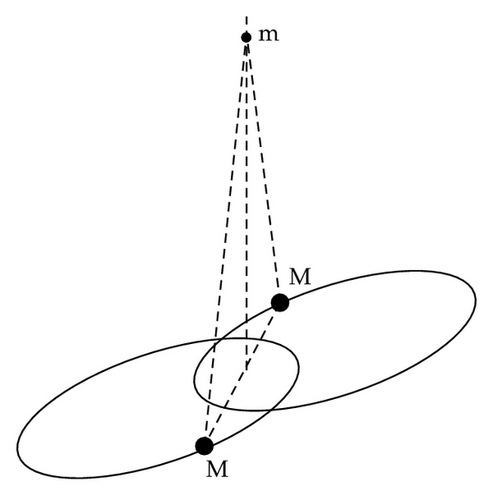
The circular Sitnikov problem is obtained when the two primary bodies describe circular orbits. This situation was originally discussed by MacMillan [2], demonstrating that this problem can be reduced to elliptic integrals. Later, several authors have analyzed the general and circular Sitnikov problem. The case when the two primaries bodies describe elliptical orbits was first investigated by Sitnikov [1], who proved the existence of oscillatory solutions for this problem. Subsequently, Moser [3] proved the existence the chaotic orbits. Perdios and Markellos [4] examined the stability and bifurcations of straight line motions of the third body. Dvorak [5] studied, by numerical means, motion of the planetoid limited to a small region around the barycentre of the primaries and found that invariant curves exist for very small oscillations centering the barycentre. For bounded orbits with moderate amplitudes, Hagel [6] showed that the equations of motion can be expressed in a polynomial form. Liu and Sun [7] derived a mapping model to investigate the problem. Wodnar [8] introduced a new formulation for the equation of motion by using the true anomaly of the primaries as independent variable. Belbruno et al. [9] derived analytical expressions for the circular case (MacMillan problem) using elliptic functions. Faruque [10] found approximate analytical solutions for small oscillations around the barycenter and moderate eccentricities. Recently, Dvorak [11] studied the complete phase space numerically. Kovács and Érdi [12] reported the extended phase space of the Sitnikov problem by using a stroboscopic map and computing escape times. The instance when the mass of the third body is nonnegligible (extended Sitnikov problem) has been studied by Dvorak and Sun [13]. Soulis et al. [14] also studied the situation in which the third body could move off the z-axis (generalized extended Sitnikov problem). In 2009, Hagel [15] derived an analytical expression for the perihelion motion of the primaries, when the third body has a finite mass.
Bountis and Papadakis [16] analyzed the problem for an arbitrary number of primary masses, Sidorenko [17] complemented the previous work on the alternation of stability and instability in the family of vertical motions. Recently, Ruzza and Lhotka [18] performed the implementation of a numerical construction of high order normal form near elliptic orbits.
In this work, we assume that the energy of the third body is close to the escape energy. In this situation, the period of the orbit is large, because the body goes to great distances from the origin and then return. The numerical calculation of the period becomes complex, mainly because computational times are very long and it becomes necessary to resort to asymptotic analysis to support the numerical calculation.
2. Equations of Motion
3. Asymptotic Expansions
The mechanical total energy (E) of the third body, can be written in terms of ε as: E = −2GMm/Rε, bounded orbit are obtained when 0 < ε < 1. In the case ε ≤ 0, an unbounded orbit is obtained, E = 0 is the minimum energy of the third body to escape of the gravitational field of the primary bodies.
If ε is a positive small parameter, the orbit of the third body is bounded but with a large amplitude, then the equation can be solved by matching between two asymptotic solutions.
3.1. Near Field
3.2. Far Field
3.3. Matching Procedure
In the region 1 ≪ z/R ≪ 1/ε, the inner and outer solutions are valid, then (3.6) and (3.13) must make matching in it.
3.4. Matching in Higher Order
4. Results
In this section, the results are expressed using dimensionless variables, the dimensionless time , and the dimensionless distance η = z/R. In this representation, the results are general and it is not necessary to give numerical values for the constants G, M and R.
Figure 2 presents the function z(t) with ε = 0.2. The solid line corresponds to the solution obtained by numerical integration of (3.1), the dashed line represents the outer solution (3.31). It can be seen that, although ε is not very small, the analytical solution is quite accurate.
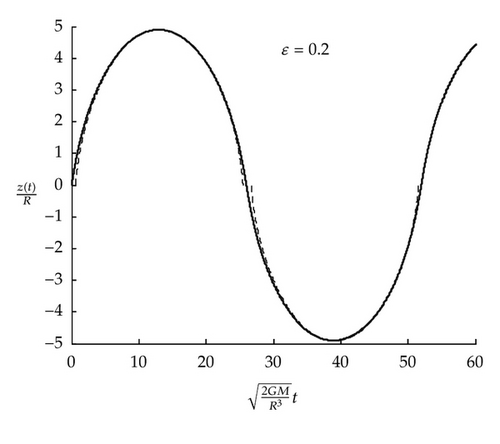
Figure 3 shows z(t) with ε = 0.2, in the first quarter period of the orbit, where the outer solution (3.31) and the inner solution (3.6) can be observed (dashed line), the numerical solution is represented with a solid line. Thus, in the region close to the origin of coordinates, the outer solution should be replaced by the inner solution. In Figure 3 you can see that the matching between the two solution is in a region centered around z/R ≈ 1.5.
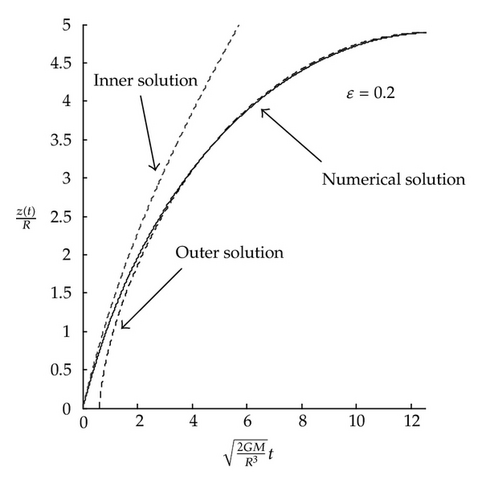
Figure 4 shows the function z(t) con ε = 0.1. The solid line corresponds to the solution obtained by numerical integration of (3.1), the dashed line represents the outer solution (3.31). It can be seen that the numerical and analytical solution are indistinguishable on this scale. This result indicates, that for values of ε ≪ 1, the movement of the third body can be well described by two analytical solutions, the inner and outer solution.
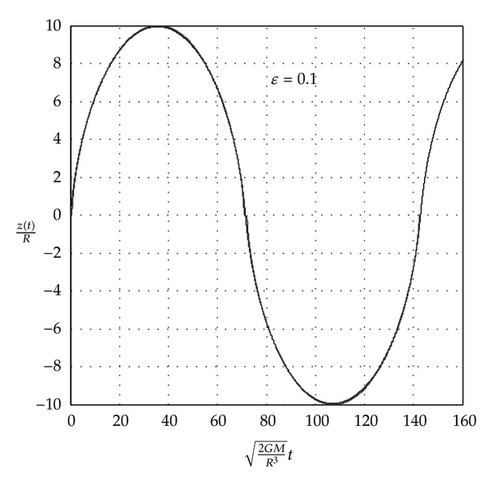
Figure 5 shows z(t) with ε = 0.1 in the region of matching between the inner solution (3.6) and the outer solution (3.31), where it can be noticed that the matching is in a region centered around z/R ≈ 2.
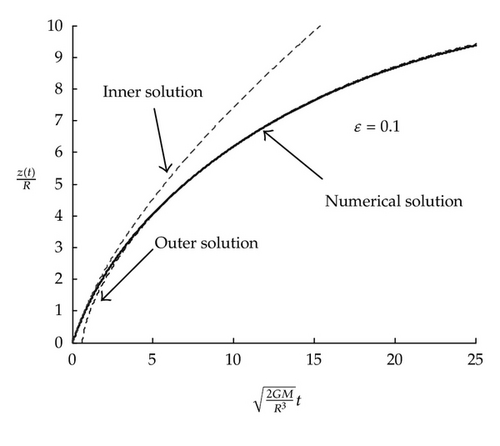
As the parameter ε → 0, the position of the region of matching between the two solutions will be centered approximately in a position 1/ε, so, in the case ε = 0, the orbit is unbounded and the inner solution is the exact solution to the orbit.
Figure 6 shows z(t) with ε = 0.1, in the first quarter period of the orbit, the dashed line represents the uniform approximation (3.19) and the solid line denotes the numerical solution. It can be seen that the numerical and the uniform approximation are indistinguishable on this scale.
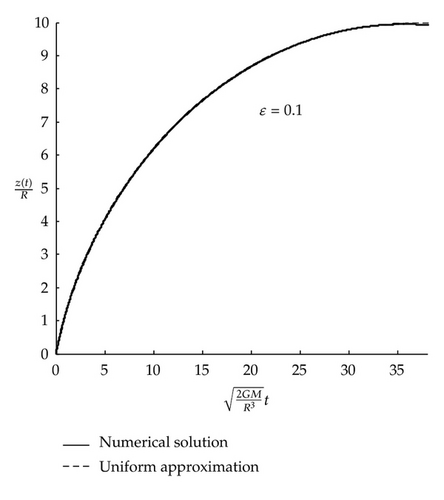
Defining the relative error between the numerical solution and the uniform approximation as |(znum(t) − zunif(t))/znum(t)|, and taking the temporal average of a quarter period, the following values for the mean relative error are obtained (Table 1).
| ε | Error |
|---|---|
| 0.05 | 0.0003 |
| 0.10 | 0.0013 |
| 0.20 | 0.0058 |
| 0.40 | 0.0250 |
Figure 7 shows the period of the orbit as a function of the parameter k defined as k2 = 1/2(1 − ε). The solid line corresponds to the period obtained by numerical integration of Macmillan equation (2.8), the dashed line represents the asymptotic solution (3.32).
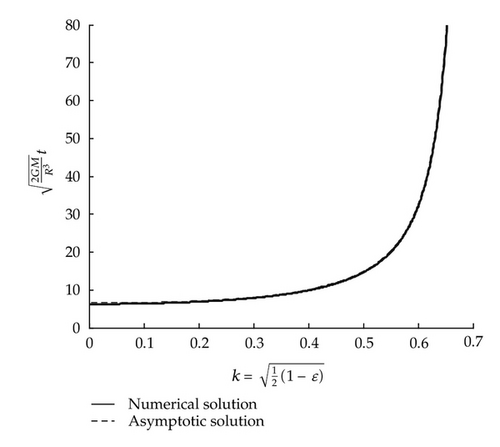
Figure 7 indicates that the asymptotic expansion (3.32) for the period of the third body matched very well with the numerical calculation of (2.8), the for the period for values of k close to .
The relative error, defined as ((Tasymp − Tnum)/Tnum), between the asymptotic solution and the numerical solution of the period of oscillations as a function of the parameter k can be seen in Figure 8. The results show that the asymptotic solution for the period of oscillation (3.32) gives good results in a wide range of values of the parameter ε. The asymptotic solution is valid in the region ε ≪ 1, that is, when k is close to . In this region the relative error is minor than 0.005. The region of small amplitudes in the movement of the third body, corresponds to ε ≈ 1, or equivalently k ≪ 1. In this region the relative error of the asymptotic solution is close to 0.04.
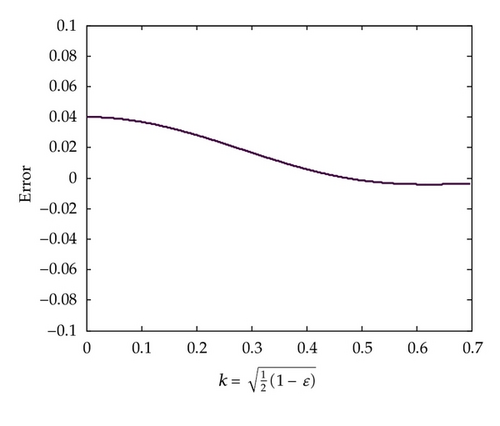
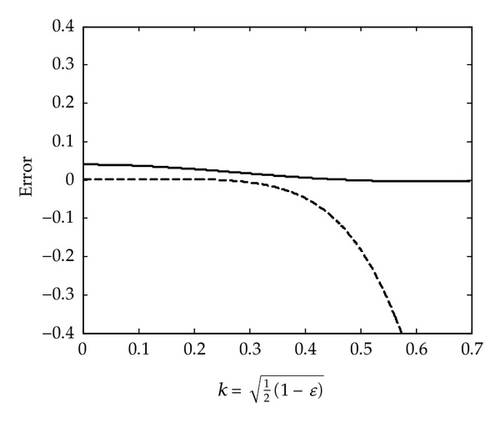
5. Conclusions
In this paper, the circular Sitnikov problem is revisited. By matching between asymptotic expansions, approximate analytical expressions for the period and the orbit of the third body in the case of large oscillation are found. The results show that for values ε ≪ 1, the movement of the third body can be well described by two analytical solutions, the inner and outer solution.
The analytical asymptotic equation to the period of the third body matched very well with the numerical calculations. It also provides an improved expression for the period of the orbit valid for the entire domain of bounded orbits.
The method of matched asymptotic expansions employed in this paper can be extended to more complex problems. For example, the elliptic Sitnikov problem, variable mass of the third body and the relativistic Sitnikov problem. In all these problems, when the speed of the third body is very close to the escape velocity, computational times are very long and it becomes necessary to resort to asymptotic analysis.




